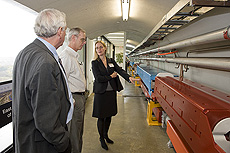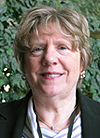|
Wednesday, Oct. 29
9-11 a.m.
Clean Air Council Energy Forum - One West
3:30 p.m.
DIRECTOR'S COFFEE BREAK - 2nd Flr X-Over
4 p.m.
Fermilab Colloquium - One West
Speaker: Thomas K. Gaisser, University of Delaware
Title: IceCube-A New Detector for Neutrino Astronomy and Particle Astrophysics
Thursday, Oct. 30
THERE WILL BE NO PHYSICS AND DETECTOR SEMINAR THIS WEEK
2:30 p.m.
Theoretical Physics Seminar - Curia II
Speaker: Lisa Randall, Harvard University
Title: Flavor Physics from Warped Geometry
3:30 p.m.
DIRECTOR'S COFFEE BREAK - 2nd Flr X-Over
4 p.m.
Accelerator Physics and Technology Seminar - One West
Speaker: Paul Derwent, Fermilab
Title: The ICD, a First Step Towards the Intensity Frontier
Click here for NALCAL,
a weekly calendar with links to additional information.
|
|
Wednesday, Oct. 29
- Portabello harvest grain
- Smart cuisine: Santa Fe chicken quesadilla
- Hoisin Chicken
- Smart cuisine: parmesan fish
- Cuban panini
- Assorted sliced pizza
- Pesto shrimp linguini w/leeks & tomatoes
Wilson Hall Cafe Menu |
|
Wednesdsay, Oct. 29
Lunch
- Magnolia chicken jambalaya
- Chocolate pecan bourbon tart
Thursday, Oct. 30
Dinner
- Closed
Chez Leon Menu
Call x4598 to make your reservation.
|
|
|
Fermilab scientists, users elected to APS DPF committee

From left: Patty McBride, Kevin Pitts and Borys Kayser.
Members of the Division of Particles and Fields of the American Physical
Society elected Patty McBride, Fermilab, as vice-chair for 2009. She will
become DPF chair in 2011. Kevin Pitts, University of Illinois, and David Saltzberg, UCLA, were elected as members of the Executive Committee and will
serve three-year terms. The new members of the DPF Executive Committee will
assume their positions on January 1, 2009.
Boris Kayser, Fermilab, will
serve as chair in 2009.
|
OSTP staffer Jean Cottam toured Fermilab Friday

Jean Cottam (right), assistant director for Physical Sciences and Engineering in the Office of Science and Technology Policy, gets a tour of the 15th floor from Steve Holmes (center), associate director for accelerators, and Dan Green, co-coordinator of the LHC Physics Center, on Friday, Oct. 24. Cottam also spoke Friday at the U.S. LHC Users meeting.
|
Fermilab hosts Clean Air Counts Energy Forum today
Fermilab will host a forum on clean energy today for the Metropolitan Mayors Caucus in One West. Fermilab FESS head Randy Ortgiesen will give a 30 minute presentation, beginning at 9 a.m. on Fermilab's energy use and the laboratory's plan to meet the DOE directive to reduce energy intensity. Representatives from Lime Energy, Energy Choices, P.C. and ComEd will also speak. Fermilab employees and users may attend, but space is limited. Learn more about Clean Air Counts.
|
The subatomic dragstrip
From MSNBC CosmicLog, Oct. 28, 2008
Most atom smashers are built like Indy racetracks, with powerful magnets bending subatomic particles into circular routes. The SLAC National Accelerator Laboratory, built in the heart of California's Silicon Valley, is something completely different: It's basically a 2-mile-long dragstrip that whips up electrons to shed light on the structure of matter.
SLAC's straight-shot structure hints at the shape of atom smashers to come - such as the future International Linear Collider. And it makes for one heck of a jogging trail.
"There's actually a race where they go down to the accelerator and back - it's four miles," said SLAC graduate student Chris McGuinness, who is an avid mountain climber as well as a researcher working on the next generation of laser-powered particle accelerators.
Next month's 37th annual SLAC Run and Walk will take place outside the accelerator's housing. But at the same time, 25 feet beneath the surface, electrons and positrons will be running their own races down SLAC's straight track.
At the end of the track, those pumped-up particles can be curled around and smashed together, or they can be captured in a magnetic ring to generate brilliant flashes of X-ray light. The smashing part has supported Nobel-winning discoveries, including this year's physics prize, but the flashing part is pointing the way to SLAC's next frontier.
Read more
|
|
|
Supporting science
Vicky White, head of the Computing Division, wrote this week's column.
 |
| Vicky White |
Last week, Patty McBride and I attended a workshop about mid-range scientific computing. Representatives from all DOE science laboratories met in Washington, DC, to talk about the science programs that create the demand for these computing and networking projects as well as the way we go about providing and managing these systems.
In calling for this workshop, Dr. Patricia Dehmer, the deputy director of the DOE Office of Science, noted, "Computing has become ubiquitous in the scientific research enterprise, and there is scarcely a research project that does not utilize computing in some way-for calculations, data taking and analysis, and modeling and simulation."
Mid-range computing is defined as systems that have more computing power than a few desktop computers or small servers but less than the capabilities of supercomputers at Argonne, Oak Ridge and the National Energy Research Scientific Computing Center at Berkeley.
At Fermilab, our mid-range systems consist of many thousands of computers. We use the systems for the Fermilab-based experiments program; the Large Hadron Collider; Lattice QCD and some other theory simulations. We also have excellent wide-area networking to support the worldwide collaborative efforts on both the computing (Grid) and the science that our programs demand.
The support of scientific computing at Fermilab goes beyond the dedicated work of computing professionals and scientists in CD. Working with the people of CD facility operations, FESS personnel has done a magnificent job of providing us with the infrastructure and facilities we need through creative re-use of existing buildings. BSS employees work hard every year to procure a mountain of computing equipment in a manner that gives the lab the best value, taking "green" factors such as energy use into consideration. Our colleagues at ANL, ESnet, Internet2, Caltech and DOE have helped us build the capable and expandable network to the world that we need.
Patty and I were proud to represent all this computing-related work-carried out safely!-in support of Fermilab scientific research at the workshop in D.C.
|
ES&H weekly report, Oct. 28
This week's safety report, compiled by the Fermilab ES&H section, lists no reportable injuries. We have now worked 18 days since the last recordable injury. Find the full report here.
Safety report archive
|
|
Have a safe day!
DreamWeaver CS3: Advanced Nov. 5
An advanced course in Dreamweaver CS3 will take place Nov. 5. Attendees can learn to establish database connectivity, work with record sets, create interactive page elements and administer database records and Web sites. Attendees can also learn to create a user authentication system. Learn more and enroll
PowerPoint 2003 class Nov. 11
A course in PowerPoint will take place Nov. 11. Attendees can learn to apply multimedia techniques to a PowerPoint presentation in order to create a slide show that will appeal to any audience. Learn more and enroll.
Interpersonal Communication Skills course Nov. 11
A course in interpersonal communication skills will take place Nov. 11 for scientific, computing, engineering and technical staff. Attendees can increase their awareness of their communication skills and personality type. Attendees can also develop skills for more productive work relationships. Learn more and enroll
Additional Activities
|
|